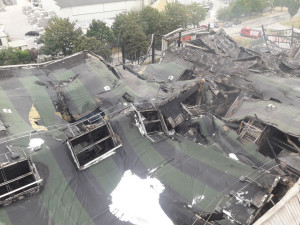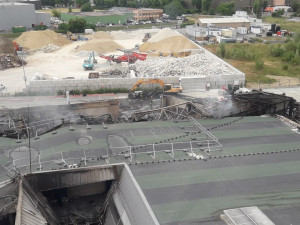A fire alarm sounded around 8:40 a.m. on a conveyor in a 6,000 m² selective waste sorting and transit centre. A verification confirmed the presence of smoke coming from a stocking machine. The personnel were evacuated. Overwhelmed by the magnitude of the fire, the personnel did not attempt to fight the fire and waited for a large contingent of firefighters (more than 80) to intervene. Two-thirds of the building had become engulfed in flames and the fire had spread to its vegetative roof. A perimeter of 300 m was set up and retention/containment measures on the site were established. A pumping system with an output of 7,000l/min. was established on the Marne River. The administrative section of the building was ventilated, although the firefighters had difficulty gaining access to the process hall: the operator used 2 power shovels to knock down one of the facades and dismantled the process elements in an attempt to bring the fire under control. Sensitive equipment was evacuated from the building. Aerial reconnaissance with a UAV was used to assess the smoke dispersion. A specialised company was called in to pump out the oil separator to prevent the retention basin from overflowing. Public works machinery was mandated to clear out the site and the extinguishing water was conveyed to the local wastewater treatment facility. The fire brigade finished up operations at the site 5 days after the fire had started.
One fireman had to be treated for heat stroke and 2 employees were treated for smoke inhalation. The 470 m³ of extinguishing water and the 370 t of damp waste were taken to landfill. Property damage totalled 15 M€. Temporary measures were needed to maintain the public waste sorting department in operation: creation of a temporary waste transfer centre and a waste sorting centre.
According to the operator, the presence of a combustion initiator in the stocker material, coupled with the high temperatures on the days preceding the fire, was responsible for the outbreak.
The operator identified the main vectors that allowed the fire to spread throughout the structure (ventilation ducts, conveyors, cladding, etc.) and has studied the modifications required during the reconstruction of the installations.





